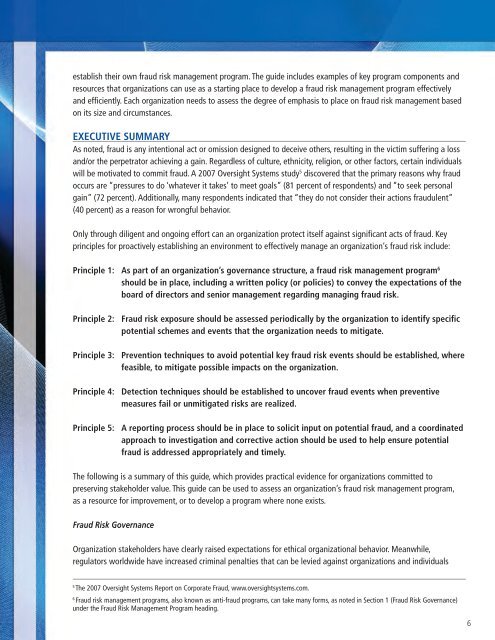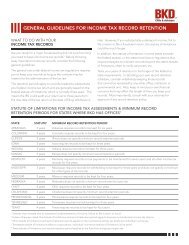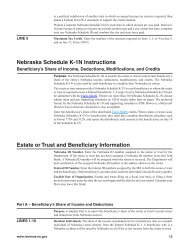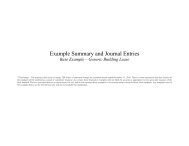Managing the Business Risk of Fraud: A Practical GuideFraud is any intentional act or omission designed to deceive others, resulting in the victim suffering aloss and/or the perpetrator achieving a gain 1 .INTRODUCTIONAll organizations are subject to <strong>fraud</strong> risks. Large <strong>fraud</strong>s have led to the downfall of entire organizations, massiveinvestment losses, significant legal costs, incarceration of key individuals, and erosion of confidence in capitalmarkets. Publicized <strong>fraud</strong>ulent behavior by key executives has negatively impacted the reputations, brands, andimages of many organizations around the globe.Regulations such as the U.S. Foreign Corr<strong>up</strong>t Practices Act of 1977 (FCPA), the 1997 Organisation for EconomicCo-operation and Development Anti-Bribery Convention, the U.S. Sarbanes-Oxley Act of 2002, the U.S. FederalSentencing Guidelines of 2005, and similar legislation throughout the world have increased management’sresponsibility for <strong>fraud</strong> risk management.Reactions to recent corporate scandals have led the public and stakeholders to expect organizations to take a“no <strong>fraud</strong> tolerance” attitude. Good governance principles demand that an organization’s board of directors, orequivalent oversight body, ensure overall high ethical behavior in the organization, regardless of its status as public,private, government, or not-for-profit; its relative size; or its industry. The board’s role is critically important becausehistorically most major <strong>fraud</strong>s are perpetrated by senior management in collusion with other employees 2 . Vigilanthandling of <strong>fraud</strong> cases within an organization sends clear signals to the public, stakeholders, and regulators aboutthe board and management’s attitude toward <strong>fraud</strong> risks and about the organization’s <strong>fraud</strong> risk tolerance.In addition to the board, personnel at all levels of the organization — including every level of management, staff,and internal auditors, as well as the organization’s external auditors — have responsibility for dealing with <strong>fraud</strong>risk. Particularly, they are expected to explain how the organization is responding to heightened regulations, as wellas public and stakeholder scrutiny; what form of <strong>fraud</strong> risk management program the organization has in place; howit identifies <strong>fraud</strong> risks; what it is doing to better prevent <strong>fraud</strong>, or at least detect it sooner; and what process is inplace to investigate <strong>fraud</strong> and take corrective action 3 . This guide is designed to help address these tough issues.This guide recommends ways in which boards 4 , senior management, and internal auditors can fight <strong>fraud</strong> intheir organization. Specifically, it provides credible guidance from leading professional organizations that definesprinciples and theories for <strong>fraud</strong> risk management and describes how organizations of various sizes and types can1This definition of <strong>fraud</strong> was developed uniquely for this guide, and the authors recognize that many other definitions of <strong>fraud</strong> exist, includingthose developed by the sponsoring organizations and endorsers of this guide.2Refer to The Committee of Sponsoring Organizations of the Treadway Commission’s (COSO’s) 1999 analysis of cases of <strong>fraud</strong>ulent financialstatements investigated by the U.S. Securities and Exchange Commission (SEC).3Refer to June 2007 SEC Commission Guidance Regarding Management’s Report on Internal Control Over Financial Reporting UnderSection 13(a) or 15(d) of the Securities Exchange Act of 1934 and U.S. Public Company Accounting Oversight Board (PCAOB) AuditingStandard No. 5 (AS5), An Audit of Internal Control Over Financial Reporting That Is Integrated With an Audit of Financial Statements, forcomments on <strong>fraud</strong> responsibilities.4Throughout this paper the terms board and board of directors refer to the governing body of the organization. The terms chief executiveofficer (CEO) and chief financial officer (CFO) refer to the senior level management individuals responsible for overall organizationperformance and financial reporting.5
establish their own <strong>fraud</strong> risk management program. The guide includes examples of key program components andresources that organizations can use as a starting place to develop a <strong>fraud</strong> risk management program effectivelyand efficiently. Each organization needs to assess the degree of emphasis to place on <strong>fraud</strong> risk management basedon its size and circumstances.Executive SummaryAs noted, <strong>fraud</strong> is any intentional act or omission designed to deceive others, resulting in the victim suffering a lossand/or the perpetrator achieving a gain. Regardless of culture, ethnicity, religion, or other factors, certain individualswill be motivated to commit <strong>fraud</strong>. A 2007 Oversight Systems study 5 discovered that the primary reasons why <strong>fraud</strong>occurs are “pressures to do ‘whatever it takes’ to meet goals” (81 percent of respondents) and “to seek personalgain” (72 percent). Additionally, many respondents indicated that “they do not consider their actions <strong>fraud</strong>ulent”(40 percent) as a reason for wrongful behavior.Only through diligent and ongoing effort can an organization protect itself against significant acts of <strong>fraud</strong>. Keyprinciples for proactively establishing an environment to effectively manage an organization’s <strong>fraud</strong> risk include:Principle 1: As part of an organization’s governance structure, a <strong>fraud</strong> risk management program 6should be in place, including a written policy (or policies) to convey the expectations of theboard of directors and senior management regarding managing <strong>fraud</strong> risk.Principle 2: Fraud risk exposure should be assessed periodically by the organization to identify specificpotential schemes and events that the organization needs to mitigate.Principle 3: Prevention techniques to avoid potential key <strong>fraud</strong> risk events should be established, wherefeasible, to mitigate possible impacts on the organization.Principle 4: Detection techniques should be established to uncover <strong>fraud</strong> events when preventivemeasures fail or unmitigated risks are realized.Principle 5: A reporting process should be in place to solicit input on potential <strong>fraud</strong>, and a coordinatedapproach to investigation and corrective action should be used to help ensure potential<strong>fraud</strong> is addressed appropriately and timely.The following is a summary of this guide, which provides practical evidence for organizations committed topreserving stakeholder value. This guide can be used to assess an organization’s <strong>fraud</strong> risk management program,as a resource for improvement, or to develop a program where none exists.Fraud Risk GovernanceOrganization stakeholders have clearly raised expectations for ethical organizational behavior. Meanwhile,regulators worldwide have increased criminal penalties that can be levied against organizations and individuals5The 2007 Oversight Systems Report on Corporate Fraud, www.oversightsystems.com.6Fraud risk management programs, also known as anti-<strong>fraud</strong> programs, can take many forms, as noted in Section 1 (Fraud Risk Governance)under the Fraud Risk Management Program heading.6
- Page 1 and 2: ACFE FRAUD PREVENTIONCHECK-UP
- Page 3 and 4: ACFE FRAUD PREVENTIONCHECK-UPThe Be
- Page 5 and 6: ACFE FRAUD PREVENTIONCHECK-UPACFE F
- Page 7 and 8: ACFE FRAUD PREVENTIONCHECK-UPACFE F
- Page 9 and 10: ACFE FRAUD PREVENTIONCHECK-UPACFE F
- Page 11 and 12: ACFE FRAUD PREVENTIONCHECK-UPACFE F
- Page 13 and 14: Sponsored by:The Institute of Inter
- Page 15 and 16: Team Members:Toby J.F. Bishop, CPA,
- Page 17: Managing the Business Risk of Fraud
- Page 21 and 22: Fraud risk identification may inclu
- Page 23 and 24: Thus, to properly address fraud ris
- Page 25 and 26: The board also has the responsibili
- Page 27 and 28: • Implementing adequate internal
- Page 29 and 30: Fraud Risk Management Program Compo
- Page 31 and 32: ecently been hired in the purchasin
- Page 33 and 34: Organizations can identify and asse
- Page 35 and 36: The Risk Assessment TeamA good risk
- Page 37 and 38: This also involves understanding th
- Page 39 and 40: - Invoices for goods not received o
- Page 41 and 42: Other RisksRegulatory and Legal Mis
- Page 43 and 44: SECTION 3: FRAUD PREVENTIONPrincipl
- Page 45 and 46: An organization’s HR group is oft
- Page 47 and 48: SECTION 4: FRAUD DETECTIONPrinciple
- Page 49 and 50: Process ControlsProcess controls sp
- Page 51 and 52: keep such information confidential.
- Page 53 and 54: will vary depending on the nature,
- Page 55 and 56: Conducting the InvestigationPlannin
- Page 57 and 58: • Extended investigation — Cond
- Page 59 and 60: Fraud ControlsDeloitte Forensic Cen
- Page 61 and 62: APPENDIX B: SAMPLE FRAMEWORK FOR A
- Page 63 and 64: APPENDIX C: SAMPLE FRAUD POLICY 41N
- Page 65 and 66: CONFIDENTIALITYThe ______________ U
- Page 67 and 68: Sample Fraud Policy Decision Matrix
- Page 69 and 70:
Identified Fraud Risksand Schemes (
- Page 71 and 72:
2) Misappropriation of:a) Tangible
- Page 73 and 74:
) Embezzlement(1) False accounting
- Page 75 and 76:
Fraud Prevention Area, Factor, or C
- Page 77 and 78:
Fraud Prevention Area, Factor, or C
- Page 79 and 80:
Fraud Prevention Area, Factor, or C
- Page 81 and 82:
Fraud Prevention Area, Factor, or C
- Page 83 and 84:
O-Organization / PersonnelO1-Leader
- Page 85 and 86:
O4.3 Enhance Operational Skills & C
- Page 87 and 88:
PR-Prevent, Protect & PreparePR1-Ge
- Page 89 and 90:
E-Periodic EvaluationE1-Evaluation
- Page 91 and 92:
I2-CommunicationI2.1 Develop Commun
- Page 93 and 94:
CriminologyFraud Prevention Program
- Page 95 and 96:
CriminologyFraud Prevention Program
- Page 97 and 98:
CriminologyFraud Prevention Program
- Page 99 and 100:
CriminologyFraud Prevention Program
- Page 101 and 102:
CriminologyFraud Prevention Program
- Page 103 and 104:
CriminologyFraud Prevention Program
- Page 105 and 106:
CriminologyFraud Prevention Program
- Page 107 and 108:
CriminologyFraud Prevention Program
- Page 109 and 110:
CriminologyFraud Prevention Program
- Page 111 and 112:
CriminologyFraud Prevention Program
- Page 113 and 114:
CriminologyFraud Prevention Program
- Page 115 and 116:
CriminologyFraud Prevention Program
- Page 117 and 118:
Sample Fraud PolicyAssociation of C
- Page 119 and 120:
Sample Fraud PolicyCONFIDENTIALITYT
- Page 121 and 122:
Sample Fraud PolicyFraud Policy Dec
- Page 123 and 124:
Fraud’s Worst Enemyhttp://www.fra
- Page 125 and 126:
ACFE Insights - ACFE Insightshttp:/
- Page 127:
ACFE Insights - ACFE Insightshttp:/









